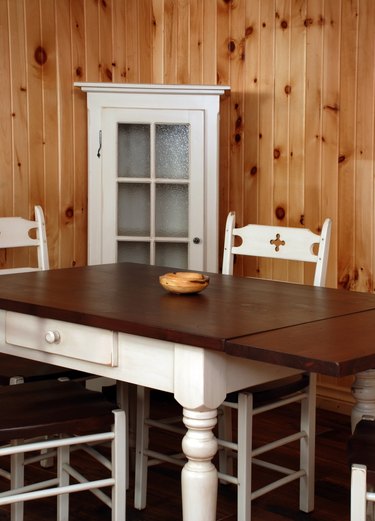
Pine is a soft, inexpensive wood that home woodworkers and professional furniture makers alike often fashion into furniture, cabinets and paneling. Its softness is a boon when you're working it, but its grain structure can create problems when the time comes for finishing or refinishing. Pine tends to soak up wood stain unevenly, and knotty pine is especially prone to blotching. The way to circumvent this problem is to seal the wood before you apply a stain or finish.
A Knotty Problem
Video of the Day
Pine is such a lightweight material compared to hardwoods because its grain structure is spacious and spongy, and if that were the end of the story, staining it would present no difficulties. The knots are dense and they contain resins that actually repel stains, however, while the wood directly surrounding a knot is extra absorbent. Consequently, stains tend to form dark blotches around knots, and because of the irregularity of the wood fibers, these blotches can extend far from a knot. The unattractive result of applying stain directly to knotty pine greatly detracts from the natural appeal of the wood.
Video of the Day
Condition or Seal Before Staining
Finishers prevent blotching in knotty pine by applying a wood sealer or conditioner before staining. Commercial wood conditioner usually consists of paraffin dissolved in a solvent, and when you brush it on the wood, the wax settles in the grain and prevents stain from soaking in. You can also use diluted lacquer or shellac as a sealer; some finishers dilute the clear finish they plan to apply over the stain and brush or spray that onto the wood before staining. As further insurance against blotching, apply stain sparingly with a rag instead of a brush, wiping with the grain of the wood.
Staining Previously Finished Wood
You have to remove the finish from a previously finished piece of wood before you can restain it, and you can do this either by sanding or stripping it with chemicals. After stripping, enough of the old finish may remain in the wood grain to eliminate the need for resealing, but because knotty pine is so absorbent and problematic, it's always a good idea to apply a coat of wood conditioner before you restain. Test the stain on an inconspicuous part of the piece, and seal the wood with diluted clear finish if blotching is still an issue.
Toning for Color Uniformity
Despite your best efforts to avoid it, you may still notice blotching on knotty pine, especially if the wood hasn't been previously finished. You can even out the color to some degree by applying one or two coats of clear finish, wiping a stain over the finish and then applying one more coat of finish. If you have spray equipment, an alternative is to make a toner by adding universal pigments to lacquer thinner and spraying the toner on the wood after applying one or two coats of clear finish. Either way, the color should even out, although the shade will become darker.